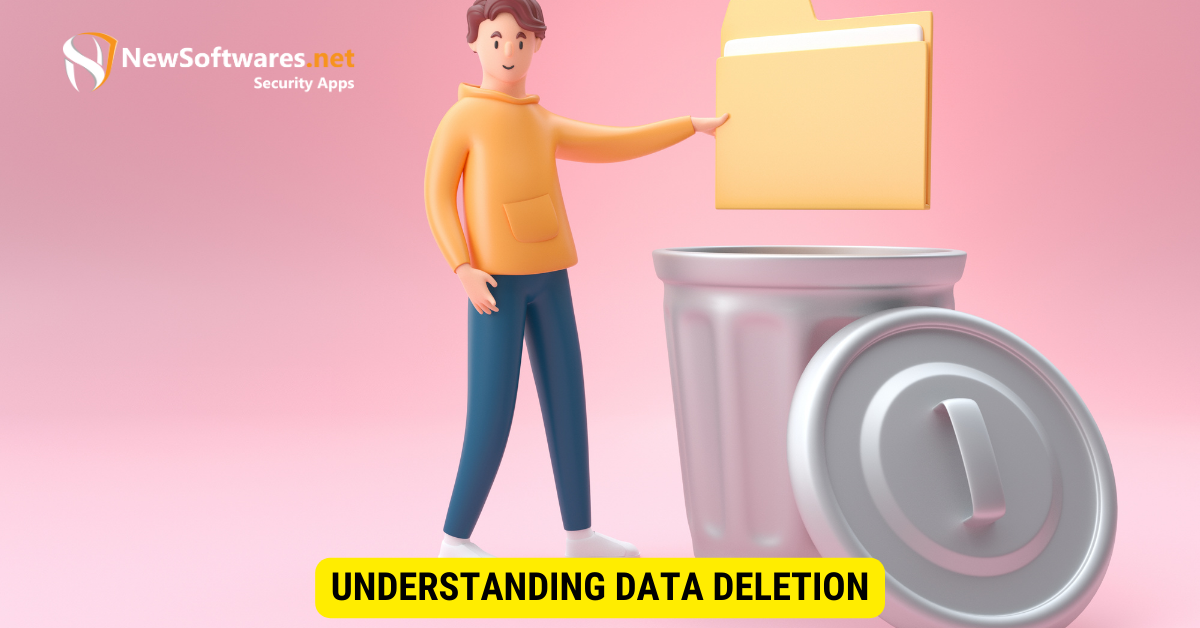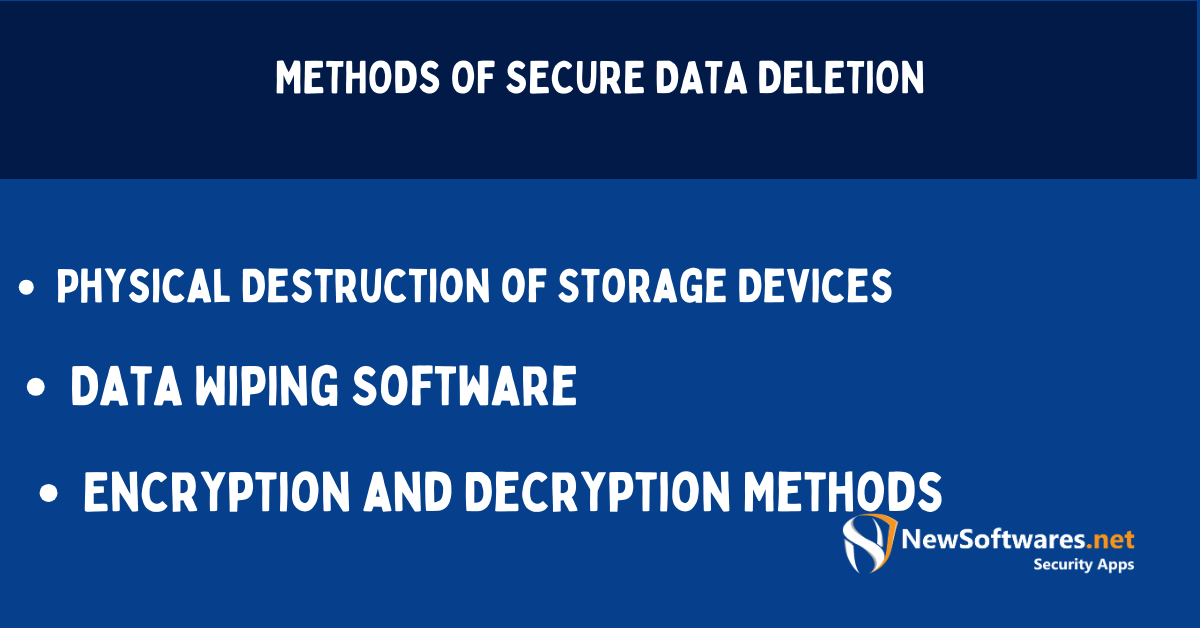For securely deleting data, use dedicated data wiping tools, overwrite old data multiple times, physically destroy storage devices, and utilize encryption before deletion.
In today’s digital age, data security has become a paramount concern. Whether disposing of an old device or simply clearing out sensitive information, securely deleting your data is crucial. We will explore the various aspects of secure data deletion, including its importance, common misconceptions, different types of data storage, methods of secure data deletion, and how to securely delete data on different devices.
Understanding Data Deletion

Deleting a file from your computer or device might make you think it’s gone for good. However, the data remains on the storage media, such as your hard drive or solid-state drive (SSD). The deletion process removes the file’s visibility to the operating system.
But what exactly happens when you delete a file? When you knock out the delete button, the operating system marks the space busy by the file as available for reuse. This means the file is no longer accessible normally, but its data is still on the storage media until it gets overwritten by new data.
The Importance of Secure Data Deletion
So, why is secure data deletion so important? Let’s say you’re selling or disposing of an old computer. If not properly deleted, someone with malicious intent could easily recover your personal information. This can lead to character theft, financial loss, or other serious consequences.
Secure data deletion ensures that your sensitive information is permanently erased and cannot be recovered. It involves overwriting the data multiple times with random patterns, making it virtually impossible to retrieve the original content. Various software tools and techniques are available to securely delete data, providing peace of mind when removing old devices or files.
Common Misconceptions about Deleting Data
One common misconception is that formatting a storage device is sufficient to erase all data. While formatting does erase the file system and makes data recovery more challenging, it does not guarantee complete data deletion. Formatting only removes the file allocation table and directory structure, leaving the actual data intact until overwritten.
Another misconception is that deleting files from the recycle bin or trash folder permanently removes them. This is not the case either. When you delete files from these locations, they are moved to a different directory on the storage media, making them no longer visible to the user. However, until their space gets overwritten, the data can still be improved using specialized software.
It is important to note that the effectiveness of data deletion methods may vary depending on factors such as the storage media type, file system, and data recovery tools. Therefore, it is always recommended to use reliable and secure data deletion techniques to ensure the complete removal of sensitive information.
Different Types of Data Storage
Before we delve into the methods of secure data deletion, let’s take a moment to understand the different types of data storage. The most common storage media include:
Hard Drives and Solid State Drives?
Hard and solid-state drives (SSDs) are commonly used in desktop computers, laptops, and servers. They store data magnetically on rotating platters or electronically on flash memory chips, respectively.
Hard drives have been the primary storage medium for periods. They consist of one or more spinning platters coated with a magnetic material. A read/write head moves across the platters to read and write data. Hard drives are known for their large storage capacities and relatively low cost per gigabyte.
On the other hand, solid-state drives (SSDs) have gained popularity in new years due to their faster performance and increased durability. SSDs use flash memory chips to stock data, allowing faster access times and improved reliability. They have no moving parts, making them less prone to mechanical failure than traditional hard drives.
External Storage Devices
Outside storage devices, such as USB flash drives, external hard drives, and SD cards, are portable and can be connected to different data transfer devices.
USB flash drives, also recognized as thumb drives or pen drives, are small, portable devices that use flash memory to store data. They are widely used for transferring files between computers and as a backup storage solution.
External hard drives are similar to inner hard drives but are housed in an external enclosure. They offer large storage capacities and can easily connect to computers via USB or other interfaces. External hard drives are usually used to back up important data or expand storage space.
SD cards, or Secure Digital cards, are commonly used in digital cameras, smartphones, and other portable devices. They are small, removable storage devices that use flash memory to store data. SD cards are accessible in different sizes and capacities, making them a convenient option for expanding storage on devices with limited internal memory.
Cloud Storage and Online Platforms

Cloud storage services and online platforms have gained popularity due to their convenience and accessibility. Your data is stored on remote attendants; you can access it from any device with an internet connection.
Cloud storage services like Dropbox, Google Drive, and Microsoft OneDrive allow users to store and synchronize files across multiple devices. These services offer a certain amount of free storage and options for upgrading to larger storage plans. Cloud storage rejects the need for physical storage devices and provides an off-site backup solution.
In addition to cloud storage services, online platforms like Google Docs, Microsoft Office Online, and Adobe Creative Cloud offer web-based applications for creating and editing documents, spreadsheets, presentations, and more. These platforms permit users to collaborate in real time and access their files from any device with an internet connection.
Cloud storage and online platforms have revolutionized how we store and access data, providing flexibility, scalability, and enhanced collaboration capabilities.
Methods of Secure Data Deletion

Now that we have a basic understanding of data storage let’s explore secure data deletion methods.
When protecting sensitive information, it is crucial to ensure that data is completely and irreversibly deleted. There are several methods available to achieve this level of security.
Physical Destruction of Storage Devices
For complete and irreversible data deletion, physical destruction of the storage device is an effective method. Shredding, drilling, or melting the device ensures no data can be recovered. This method is often used by organizations that deal with highly sensitive information, such as government agencies or financial institutions.
When a storage device is shredded, it is broken down into small pieces, making it virtually impossible to retrieve any data. Similarly, drilling holes into the device or melting it into a molten state ensures that the data stored on it is destroyed.
Physical destruction is a reliable method for data deletion, but it is important to note that it is irreversible. Once the device is destroyed, there is no way to recover the stored data, so caution must be exercised when choosing this method.
Data Wiping Software
Data wiping software, or secure file erasers or disk sanitizers, are programs designed to overwrite data multiple times. This makes it nearly impossible to recover the original information. These software applications use advanced algorithms to overwrite the existing data with random characters, making retrieving the original content extremely difficult for any data recovery methods.
One of the advantages of using data-wiping software is that it allows for selective deletion. Users can delete specific files, folders, or even entire storage devices. This flexibility is especially useful when only certain parts of the data need to be securely deleted while preserving other information.
It is worth noting that the effectiveness of data-wiping software depends on the number of times the data is overwritten. The more times the data is overwritten, the more secure the deletion becomes. Some software programs offer customizable options, allowing users to choose the number of overwrites to suit their specific security needs.
Encryption and Decryption Methods
Encryption is another way to protect your data. Encrypting your files or entire storage devices renders the data unreadable without the encryption key. Encryption uses complex algorithms to scramble the data, making it unintelligible to anyone who does not possess the decryption key.
Decryption is the process of reversing encryption to make the data accessible again. Only the correct decryption key can decipher and access the encrypted data. This method is extensively used to protect sensitive information during storage and transmission.
Different encryption algorithms are available, each with its own level of security. Some commonly used encryption algorithms include Advanced Encryption Standard (AES), RSA, and Blowfish. These algorithms ensure that even if an unauthorized person gains access to the encrypted data, they cannot decipher it without the encryption key.
It is important to keep the encryption key secure and separate from the encrypted data. Losing the encryption key can result in permanent data loss, as there is no way to recover the encrypted information without it.
By employing these secure data deletion methods, individuals and organizations can ensure that their sensitive information remains protected even after it is no longer needed. Whether through physical destruction, data-wiping software, or encryption, taking the necessary steps to delete data securely is essential in today’s digital age.
Secure Deletion for Different Devices
Now that we have explored secure data deletion methods let’s discuss how to apply them to different devices.
Securely Deleting Data on Windows
You can use built-in tools like Cipher or third-party software like erasers to delete data on Windows securely. These tools can overwrite free space, specific folders, or entire drives.
Securely Deleting Data on Mac
Mac operators can use the built-in Disk Utility or third-party tools like ShredIt X to delete data securely. These tools offer options to overwrite data and ensure it cannot be recovered.
Securely Deleting Data on Mobile Devices
You can execute a factory reset to delete data on mobile devices like smartphones and tablets securely. This will return the device to its original settings, erasing all personal data.
Key Takeaways
- Merely ‘deleting’ does not remove data completely.
- Overwriting old data multiple times ensures it’s hard to recover.
- Physical destruction of storage is the most surefire method of data disposal.
- Using dedicated data-wiping tools can automate the secure deletion process.
- Encrypt data before deleting it to add an extra layer of security.
FAQs
Q: Why isn’t simply deleting files enough?
A: ‘Deleted’ files can often be recovered with special software. True deletion requires overwriting or physical destruction.
Q: How does overwriting old data help?
A: Overwriting data makes the original data nearly impossible to recover by disrupting its digital footprint.
Q: What tools can help securely delete data?
A: Software like DBAN, Eraser, or Secure Erase can assist.
Q: How do I physically destroy storage devices?
A: Shredding, drilling, or using specialized destruction services can help.
Q: Why encrypt data before deletion?
A: Encryption ensures that it remains unreadable even if data is somehow recovered.
Conclusion
In conclusion, securely deleting your data is crucial in today’s digital world. Understanding the importance of secure data deletion, debunking common misconceptions, and utilizing different methods based on the type of data storage are all essential steps in protecting sensitive information. By following the appropriate secure deletion methods for different devices, you can ensure that your data remains confidential and inaccessible to unauthorized individuals.
